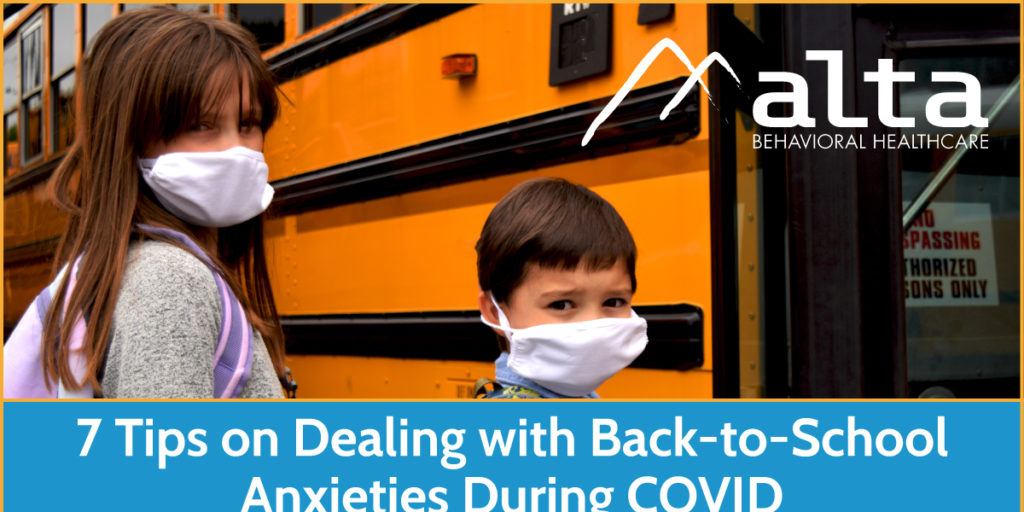7 Tips on Dealing with Back-to-School Anxieties During COVID
The start of a new school year always brings about change, and students respond to those changes with a range of feelings. From eager excitement to eagerness to sadness and dread, every child responds differently in times of change. But the start of the 2020 school year in particular will also add a completely new set of changes for both students and parents.
We are here to help. Here are seven tips to help you and your child be prepared to meet these challenges and have a successful school year:
-
Prepare for the regular school routine.
Getting back in the school routine is always tough after the summer, but this year it’s been almost 6 months since kids were in school! This will make it even harder to get into a new schedule for eating and sleeping, so allow more time for your child to establish a new schedule. Gradually starting to move times for waking up and meals a week before school starts will make the process easier. Skills for sitting still and being quiet and focused may also be out of practice, so spending time reading with your child, or doing some math or writing work will also help the transition.
-
Prepare for the new school routine.
This year students will have to do things that are not usually a part of school. From wearing masks, to temperature checks, to social distancing, to logging on to zoom calls, children should prepare for the new routine. For younger children, it may be helpful to talk about your school’s new procedures and practice with them at home to make them less intimidated. Doing a temperature check and practicing wearing a mask while reading or playing can help to make this more familiar and comfortable. For older students, talking through what social distancing will look like throughout the school day can help to prepare them for new routines in the hallway and cafeteria.
-
Prepare for a changing school routine.
Most schools have developed plans that allow them to adapt to changing health concerns. That means that your child’s school routine will likely change at least once during the school year! Prepare your child for learning online, in the classroom, or a blend of both. Remind them that they can learn in all of these options and reassure them that you will be there to help them along the way.
-
Talk about feelings.
Many children may be nervous about returning to school, and specifically worry about whether it is safe to be there. It is important to reassure your child that part of the reason that school will look different this year is because of all of the changes made to keep them safe. You can also encourage and empower your child be reminding them of the things that they can do to help stay safe, especially social distancing, wearing masks, and hand washing. Children may have other feelings about going back to school, and it’s important to let them share those too! Be sure to talk with your child about what they think school will be like, and help them identify and express the feelings they are having.
-
Find opportunities to grow.
Going back to school won’t be the last time your child has to deal with uncertainty, so it’s a great opportunity to teach them skills for dealing with difficult situations. Modeling a positive outlook and using coping skills can set a great example for your child to follow. As you talk with your child and they share a problem, don’t jump in too quickly to solve it for them! Instead, help them think through creative solutions and alternatives. You can also teach them to look at things differently, so that they feel better about a situation. For example, your child might say “I’m mad because we have to sit behind shields at lunch, and can’t touch each other.” You can help your child think more positively by acknowledging the feeling, but viewing the situation from a more positive perspective. “I know you’re frustrated by the shields at lunch, but it’s nice that you get to see your friends every day now, and can talk to them at lunch.”
-
Keep up the conversation.
No matter how your child is feeling about going back to school, their feelings will probably change. After a few weeks, things may not seem so bad—or they may seem a lot worse! Be sure to check in regularly with your child to ask them how things are going, and how they are feeling about it. And look for opportunities to encourage them and affirm the effort they are putting forth to be successful. A positive word as they start the day, or a note to find at lunch, can make a big difference in your child’s outlook!
-
Get help if you need it.
The additional stress of going back to school this year will be a lot for any child. But if can be harder for students who tend to be worriers, have a history of difficulty at school, have other significant sources of stress, or who have existing mental health challenges. Pay attention to how your child is managing the return to school, and reach out for help if you need it. Alta’s services are still available both in person and through telehealth (including telephone and videoconferencing). If you ever need anything, our staff would love to be there to help you through whatever you are going through. Don’t be afraid to contact us at 330-793-2487.


